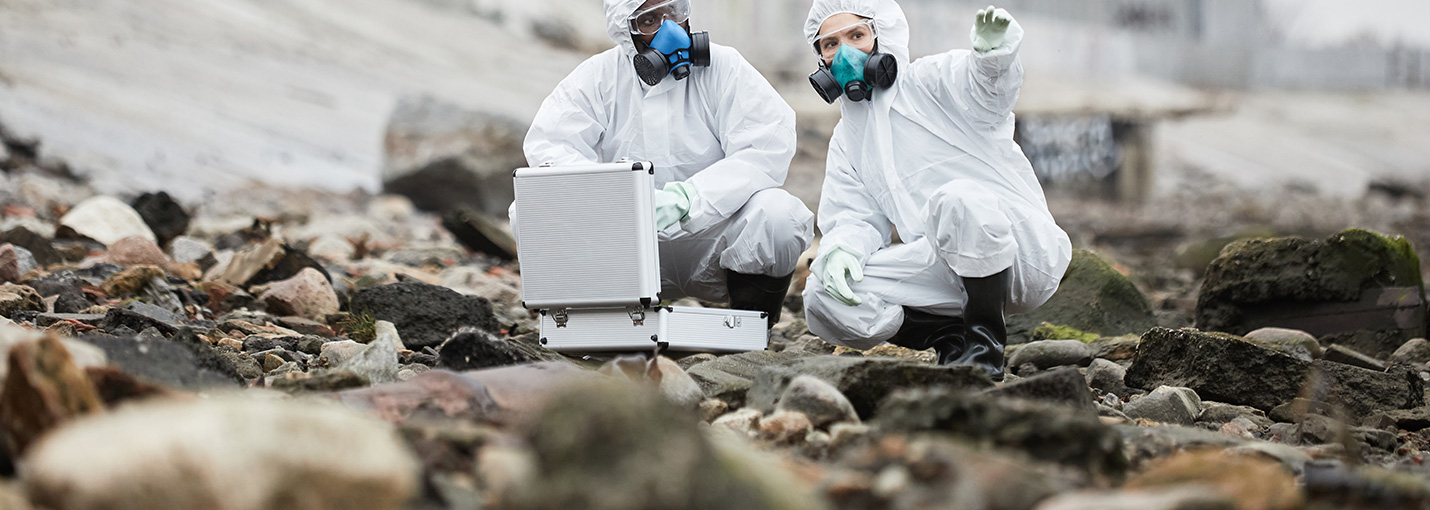To be a properly trained asbestos professional and obtain accreditation, one must be trained in a state -provided training program or by a provider that offers Environmental Protection Agency (EPA)-approved courses which follow the Asbestos Model Accreditation Plan.
!
If you believe that you were exposed to asbestos, even as a child, speak to a healthcare provider about tests and screening to help diagnose lung-scarring and screen for asbestos-related diseases.
What does licensing for asbestos workers require?
Asbestos abatement in most states requires certain education and training.
Be sure your asbestos abatement professional is licensed and up to date on required methods and knowledge.
Most states require a license to perform asbestos work. A certificate of course completion is needed to apply for a license. There are five disciplines of asbestos training. They are:
- Asbestos Abatement Supervisor
- Asbestos Abatement Worker
- Inspector
- Management Planner
- Project Designer
  |
| Nearly every building constructed before the mid-1980s contained asbestos products and building materials. |
  |
Importance of a ‘Licensed’ Asbestos Removal Company
Those who come into contact with asbestos often develop life-threatening conditions like lung, ovarian, kidney, and thyroid cancer as well as asbestosis and mesothelioma. Ignoring the risks in a home or other building is not wise. Trying to remediate without professional help or the proper training is equally as dangerous.
“The overall evidence suggests there is no safe level of asbestos exposure.”Source: National Cancer Institute (NIH)1 |
With asbestos on your property, don’t hide your head in the sand (or paint).
Painting over asbestos-containing materials, tearing them out of walls, or burying them is not illegal. Still, it is not proper remediation and can expose the owner of the building to health and legal issues. Proper techniques, tools, and protective equipment are crucial in preventing accidental exposure to anyone in the area. Professionals are trained to remove asbestos from the vicinity properly. When hiring a remediation company, it’s important to ask for the company’s credentials to prevent a disaster.
Asbestos has no taste or smell.
You may not know you’re breathing it.


The Investment in Hiring an Asbestos Removal Contractor
There is no sugarcoating the fact that asbestos removal is expensive. While removing or encapsulating asbestos on your own can save as much as $75 to $200 per hour, it is not recommended, and the cost of improper removal can far outweigh any savings in the long run. Moreover, some local ordinances restrict or ban DIY asbestos removal altogether.
Asbestos work is dangerous and requires the proper safety equipment, sealant, a HEPA vacuum, and a means of properly disposing of it. All these things add to the safety risk and expenses. Asbestos abatement is costly, but hiring an asbestos removal company saves hassle, time, and severe health risks.
Several health studies have shown that the spouses of asbestos workers are at an elevated level of risk for asbestos illnesses like lung cancer. 2 3 4 5
Regulations on the removal of asbestos and licensing to complete this work can vary by state.
But there are important federal regulations about asbestos to know as well.
Strict laws regulate the demolition, encapsulation, demolish, and disposal of asbestos. Hiring a professional protects against potential violations. Asbestos is a carcinogen and DIYers can easily inhale fibers. Most people do not have proper PPE equipment and a commercial HEPA vacuum. Removal contractors have these things handy, are familiar with the local and state laws and have the required permits and licenses to do the work safely and effectively.
“Some asbestos fibers may bypass…your body’s natural defenses…and lodge deep within your lungs. Those fibers can remain in place for a very long time and may never be removed.”Source: American Lung Association |
Health Contamination Risks
Asbestos exposure typically occurs when people breathe air in workplaces that use or make asbestos. Buildings containing asbestos can have fibers in the air when renovated or torn down. Serious cancer and lung problems can develop due to asbestos exposure.
Natural disasters like tornadoes, floods, hurricanes, and wildfires can damage materials containing asbestos, leading to nearby residents, cleanup crews, and first responders being exposed to airborne fibers. The amount of asbestos released into the air during a fire is relatively low, however, clumps of debris that linger after the fact can increase the likelihood of exposure.
“All forms of asbestos are carcinogenic to humans.” 6
Legal Liability Risks to Landlord
Typically, a landlord is legally responsible for making a building or dwelling reasonably safe for tenants. They should be aware of possible asbestos exposure and eradicate the issue if needed. Defendants in property owner negligence claims may receive compensation for injuries, emotional distress, and other noneconomic losses as a result of living in a space with asbestos.
Before compensation is awarded, a lawyer must prove lack of adequate care or negligence with credible and convincing evidence. The burden of asbestos exposure proof is relatively easy. Most lawyers can establish proof based on the nature of the injury or accident as well as through permits and other building records.
“Generally, those who develop asbestos-related diseases show no signs of illness for a long time after exposure.”Source: National Cancer Institute (NIH)7 |
On the other hand, assumption of risk is a common defense in insurance claims. A property owner is not legally responsible if a victim voluntarily assumes a known risk. Any structure built before 1980 likely contains asbestos, and while landlords should take steps to prevent contamination, contracts may explicitly specify this risk.


Real Estate Transactions
A real estate transaction may require an evaluation that tests for asbestos and removal if discovered. A lender may require an asbestos audit assessing environmental liabilities that could impair a borrower’s ability to make payments or damage their credit rating.
Parties who wish to put a property on the market may conduct an asbestos audit to make informed decisions or evaluate possible risks. Depending on the location, some states require inspection, disclosure, and removal. Mass abatement was done in many schools due to the presence of asbestos, for example.
Smokers exposed to asbestos are up to 50 times more likely to develop lung cancer than nonsmokers who aren’t exposed.8 |
Testing for Asbestos
Using a licensed and qualified expert is the best and safest way to conduct asbestos testing. Experts closely follow EPA safety guidelines for collecting samples, abatement, and disposal. Extracted samples are sent to a specialized asbestos analysis lab. There are asbestos testing kits available for DIYers as well. The instructions need to be followed to the letter in order to minimize harm.
Do You Qualify For Compensation?
Quickly and easily find out how you were exposed by searching W.A.R.D., the largest asbestos database on the planet.
FREE SEARCH >Risks of Abatement Work
The easiest, safest method of asbestos removal is hiring an asbestos abatement company. They have the experience, specialized tools, and materials to remove it. Asbestos is linked to various respiratory diseases and cancers. If not working with a licensed contractor, it’s necessary to take several precautions when attempting to touch anything that may contain asbestos, such as:
- Wearing a face mask to prevent inhaling asbestos fibers.
- Covering any exposed skin.
- Wearing disposable old clothes and gloves.
- Putting bags over shoes or wearing shoes that can be thrown away.
- Wetting the asbestos to prevent it from becoming airborne.
- Sweeping asbestos into bags designed specifically for its removal.
- Double sealing these bags.
- Wetting the area again to flush any remaining particles.
- Taking the bags of asbestos to a particular landfill made for its disposal. Calling a professional to haul it away is the best way to ensure it’s not placed with regular waste.
Sharing a home or vehicle with someone wearing asbestos-tainted clothing puts you at risk of asbestos-related diseases. 9
Danger to Employees
Certain occupations, such as construction workers or factory, refinery, foundry, or shipyard employees, may be exposed to asbestos hazards. Workers who renovate and demolish older buildings are also at risk.
Asbestos’s durability and heat resistance made it useful in HVAC installation before the 1980s. It was used in piping insulation, door gaskets, air duct covers, boilers, and oil and coal-burning furnaces. Due to the number of areas subject to asbestos exposure risk, it is best to call a professional to prevent health issues later.
Over $30 Billion is still available (No lawsuit. No fees unless you receive money. No risk.) Stake your claim.   |
Another area of widespread use of asbestos was in roofing. Any siding, underlayment, or shingles manufactured before the mid-1980s may contain harmful asbestos. Removing moss from asbestos garage roofing is dangerous. There are also risks for drywall workers. Workers should wear protective clothing when working around known or potential asbestos exposure.
The health risks of asbestos exposure can include:
| Mesothelioma: cancer of the mesothelium, the thin layer of tissue surrounding the body’s organs. This cancer is only known to be caused by asbestos exposure. | Lung cancer |
| Laryngeal cancer: cancer of the larynx (section of the throat called the voicebox) | Ovarian cancer |
| Stomach cancer | Colon cancer |
| Pharyngeal cancer | Asbestosis: a chronic lung disease associated with asbestos exposure |
| Chronic Obstructive Pulmonary Disease (COPD) | Atelectasis (collapsed lung) |
| Pleural effusion (collection of fluid around the lungs) | Pericardial effusion (collection of fluid around the heart) |
Asbestos Certification Process
There is a high demand for asbestos remediation making this a potentially lucrative career.
There are several things you must do to become certified in asbestos work.
- Take EPA-approved courses for the type of asbestos work you wish to do and achieve certification.
- Apply for a license.
- Obtain an insurance policy in case of a mishap during the removal process.
- Ensure you have all of the proper safety equipment readily available to do the job.
If done properly, asbestos abatement can be a well-paying business.
There are plenty of older structures requiring remediation or removal that need licensed contractors to do the job. Following the proper protocols and maintaining necessary equipment and gear can ensure this line of work is also safe and rewarding.
AsbestosClaims.Law
At AsbestosClaims.Law, our mission to secure compensation for asbestos victims is more than professional; it’s personal.
Our founder, Justinian C. Lane, understands the devastating impacts of asbestos firsthand.
Both his grandparents and father, all asbestos workers, passed away from asbestos-induced cancers without realizing their eligibility for asbestos lawsuits or other forms of compensation.
We aim to prevent such tragic oversights by informing and guiding victims and their families through their legal options.
If you or your loved ones have suffered as a result of asbestos exposure, you could be eligible for considerable compensation. These funds could provide for medical treatments, asbestos removal services, and safeguard your health.
In addition, asbestos trusts offer compensation without the need for a lawsuit, providing a quicker, simpler path to justice.
Reach out to us at [email protected] or (206) 455-9190 for assistance with your claim. We offer compassionate listening, clear explanations, and we don’t charge a dime unless we win your case.
Beyond legal claims, we also advise on veterans’ disability, social security, and employment protection like workers’ compensation, FELA, and The Jones Act for maritime workers.
There’s no risk or cost to connect with our experienced team about your rights. Our commitment to your well-being means no fees unless you receive compensation.
| For further queries or concerns about asbestos, explore our website and YouTube page, featuring infographics, videos, and answers to common questions on asbestos-related topics. |
We’ve also introduced W.A.R.D., the Worldwide Asbestos Research Database. It’s the most comprehensive resource for asbestos-related information.
W.A.R.D. assists in pinpointing potential exposure scenarios, asbestos-containing products, and can indicate the types and potential amounts of compensation you may be entitled to receive.
Don’t delay — get in touch with us today!
Scholarly Reference: Full article: Asbestos-related cancers: the ‘Hidden Killer’ remains a global threat (tandfonline.com)
1 National Cancer Institute (NIH), Asbestos Fact Sheet.
2 Ferrante, D., Bertolotti, M., Todesco, A., Mirabelli, D., Terracini, B. and Magnani, C., 2007. Cancer mortality and incidence of mesothelioma in a cohort of wives of asbestos workers in Casale Monferrato, Italy. Environmental Health Perspectives, 115(10), pp.1401-1405.
3 Miller, A., 2005. Mesothelioma in household members of asbestos‐exposed workers: 32 United States cases since 1990. American journal of industrial medicine, 47(5), pp.458-462.
4 Reid, A., Heyworth, J., De Klerk, N. and Musk, A.W., 2008. The mortality of women exposed environmentally and domestically to blue asbestos at Wittenoom, Western Australia. Occupational and environmental medicine, 65(11), pp.743-749.
5 İşten, B.H.S.T.O. and Maruziyetler, E.T., 2021. Exposures Moved from Work to Home as a Public Health Hazard.
6 IARC Working Group on the Evaluation of Carcinogenic Risks to Humans. Arsenic, metals, fibres, and dusts. IARC Monographs on the Evaluation of Carcinogenic Risks to Humans. 2012 ;100(Pt C):11-465. PMID: 23189751.
7 National Cancer Institute (NIH), Asbestos Fact Sheet.
7 Klebe, S., Leigh, J., Henderson, D.W. and Nurminen, M., 2020. Asbestos, smoking and lung cancer: an update. International journal of environmental research and public health, 17(1), p.258.
10 Anua, S.M., Semple, S., Shakri, S.F.M., Safuan, S., Mazlan, N. and Asri, A.A.M., 2019. A review of the take-home exposure pathway of workplace hazards. International Journal of Medical Toxicology & Legal Medicine, 22(3and4), pp.13-19.




